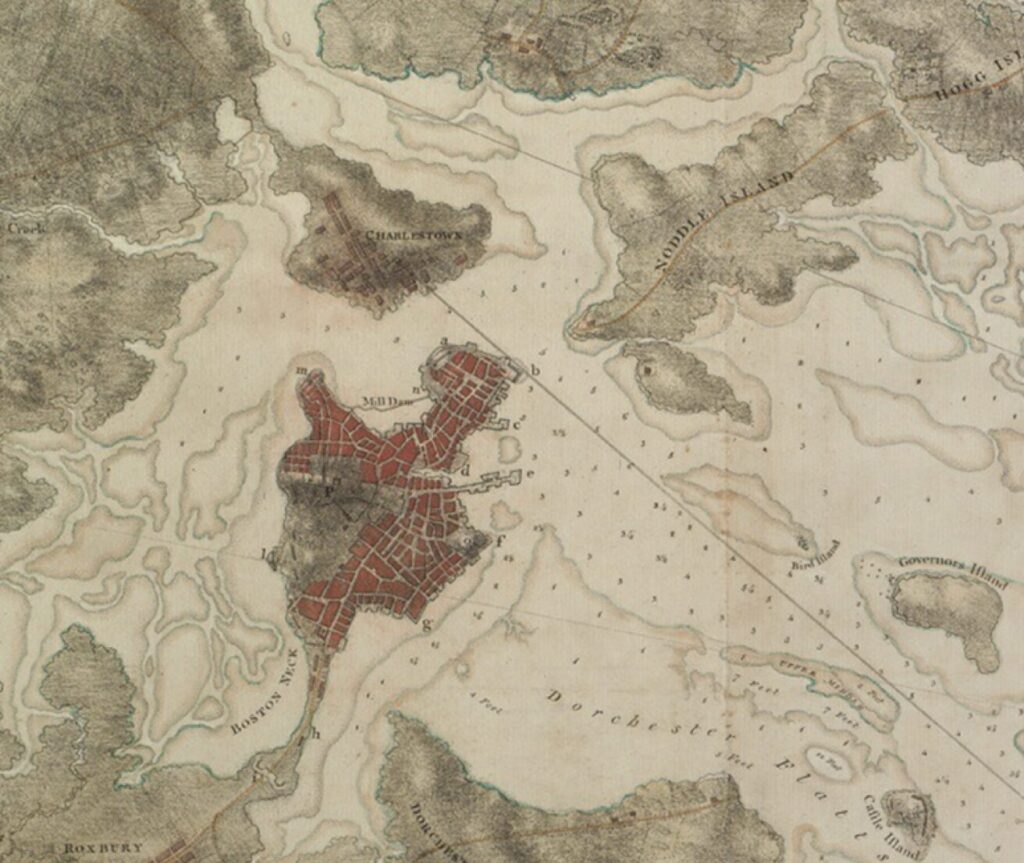A series of articles by the Reading Antiquarian Society
After April 19, 1775, many of Reading’s men returned home. Some stayed to begin the Siege of Boston. It is hard to imagine how the Colonists would have been able to enforce a siege. But Boston did not look like it does now. The photograph on the right shows a map of Boston in 1775, which shows that it was almost completely surrounded by water. The only access by land was on Boston Neck. It truly was a standoff. The Colonists had a large force, but the British had control of the harbor. Their ships with cannons would deter any efforts to attack the city. (A very interesting interactive map can be found on the National Park website, which shows the 1775 map laid over the current map of Boston. It shows the fortifications set up by both the British and the Colonists. And you can see where the land has since been built up and/or filled, like the Back Bay.)

Within a few days of April 19, an estimated ten to twelve thousand Colonists surrounded General Thomas Gage and the British Garrison. But there was no organization. The Provincial Congress met in Watertown and ordered General Artemus Ward to organize the troops. Monday, April 24, was enlistment day for the establishment of a Provincial Army. For some unknown reason, it was decided that the length of enlistment would be three months and 14 days. Capt. John Brooks, leader of Reading’s Company of Minute decided to sign on. He was promoted to Major in Col. Ebenezer Bridge’s Middlesex Regiment. According to Bruce Morang in his “A Town that Went to War”, many Reading men signed up including: Lt. James Bancroft; Caleb Bancroft; John Brooks (who served until June 13, 1783); Stephen Buxton; Joshua Eaton, (18); and his younger brother Charles (16), fifer; Thomas and William Eaton (two sons of Capt. Thomas Eaton who had led the Third Parish Company on April 19); Sgt. Abraham Foster; Joseph Hill; Richard Mason; Joseph and Nathan Parker, and Daniel Pratt (all of whom were also in the Reading Company of Minute); and James Symonds.
Nearly half of the men from the three parishes of Reading (which would become Wakefield, North Reading, and Reading) stayed in Cambridge. And many of the others who had returned home returned later to serve again. The effect on the Town must have been great. It was spring – planting season. With so many men away, it was up to the women, older men, and the children to manage the work. During the course of the Revolution, over 500 men from the three parishes were listed on the rolls as having served.
Now, a new task became quickly apparent. This new army needed to be clothed, fed, and kept warm. Towns were required to provide supplies to that end, including many cords of wood for cooking and heat. And Reading, because of its close proximity to Boston, became a location for collecting and delivering supplies to the troops.
What follows is an inventory receipt by Nathaniel Bancroft:
“Reading, April 26, 1775
An invoice of Provincial stores which I Received & Stored in Reading Meeting House and (inventory) it is followeth:
51 Barils of Porke
63 Barils of Flower
6 Barils of Beef
16 Bushels of Rye
A true copy Errs. Excepted”
Not only did the town store supplies, but some of the men were needed to cart the goods to the army. In Joseph Bancroft’s account book, dated May 5, 1775, “I carted eight barrels of pork from Reading to Watertown Bridge.”
In Part 7, we will tell about one of the next major events of the War, the taking of Fort Ticonderoga.
